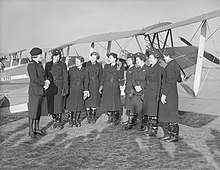Margaret Fairweather
Margaret Fairweather (23 September 1901 – 4 August 1944) was a British aviator and one of the first eight women members of the Air Transport Auxiliary (ATA). She was the first woman to fly a Supermarine Spitfire.
Margaret Fairweather | |
|---|---|
.jpg) One of the first eight | |
| Born | Margaret Runciman 23 September 1901 West Denton Hall, near Newcastle upon Tyne |
| Died | 4 August 1944 (aged 42) |
| Cause of death | Extensive skull fracture caused by plane crash |
| Resting place | Dunure Cemetery |
| Monuments | She and her husband are both noted on a rare double CWGC headstone. |
| Nationality | British |
| Education | Girton College, Cambridge |
| Occupation | Aviator |
| Spouse(s) |
|
| Children | Elizabeth Fairweather |
| Parent(s) | Hilda Stevenson and Walter Runciman, 1st Viscount Runciman of Doxford |
Life
Fairweather was born in 1901 in the West Denton part of Newcastle upon Tyne. Her mother, Hilda Runciman, Viscountess Runciman of Doxford and her father Walter Runciman, 1st Viscount Runciman of Doxford were both members of parliament.[1] She was educated at Notting Hill High School for Girls[2]

She was an instructor for the Civil Air Guard at Renfrew.[3]
After war was declared in 1939, she was one of the first eight women members of the Air Transport Auxiliary (ATA).[4] She flew many planes including Tiger Moths and Hurricanes, and was the first woman to fly a Supermarine Spitfire.[5]
Shortly after the death of her husband, Douglas, piloting an ATA aircraft on 3 April 1944, she died in a crash on 4 August that same year; also on board was her sister Kitty who was injured. The original cause of the aborted mission was a mechanical problem with the fuel tank.[6][7] Because of the lack of fuel Margaret was obliged to make a forced landing in Cheshire which went well until they hit a ditch and she lost control as the Percival Proctor flipped over. She had the worst injuries and despite being rushed to a hospital she died the next day. She had only just returned to work after giving birth. She and her husband are the only ATA couple to share the same grave and headstone. They are buried at Dunure cemetery in Ayrshire.[8]
Legacy
A bus company in Hatfield named its eight buses after the "first eight" of the Tiger Moth pilots in the ATA, including Fairweather.[9] The fifteen surviving women members of the ATA (and 100 surviving male pilots) were given a special award in 2008 by the Prime Minister Gordon Brown.[10]
References
- "Fairweather [née Runciman], Margaret (1901–1944), airwoman | Oxford Dictionary of National Biography". www.oxforddnb.com. doi:10.1093/ref:odnb/67665. Retrieved 2 March 2020.
- Oxford Dictionary of National Biography ISBN 978-0198614111
- Hyams, Jacky (2012). The Female Few: Spitfire Heroines of the Air Transport Auxiliary. Stroud: History Press. ISBN 9780752481227.
- Nigel Cawthorne (22 May 2013). The Battle of Britain. Arcturus Publishing. p. 54. ISBN 978-1-78212-669-0.
- Lewis, Jon E. (7 February 2013). Spitfire: The Autobiography. Little, Brown Book Group. ISBN 9781472107824.
- A. Mills (15 May 2006). Sex, Strategy and the Stratosphere: Airlines and the Gendering of Organizational Culture. Palgrave Macmillan UK. p. 94. ISBN 978-0-230-59570-5.
- Mace, Terry. "Margaret Fairweather". A Fleeting Peace (blog). Retrieved 30 October 2016.
- Ellis, Mary; Foreman, Melody (30 November 2016). A Spitfire Girl: One of the World's Greatest Female ATA Ferry Pilots Tells Her Story. Pen and Sword. p. 48. ISBN 978-1-4738-9539-3.
- "Inspirational ATA Female Pilots Honoured". Women in Transport. Retrieved 1 March 2020.
- "Britain's FEMALE Spitfire pilots to receive badge of courage at last". Evening Standard. 21 February 2008. Retrieved 1 March 2020.